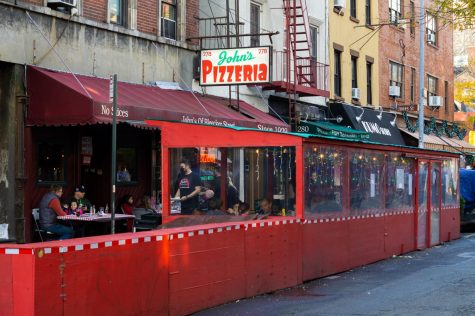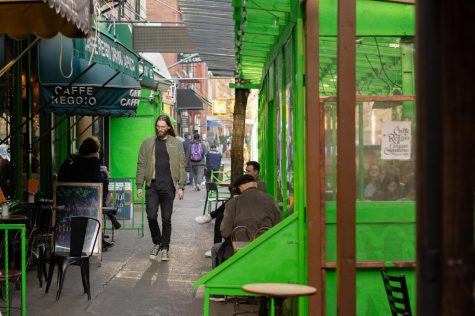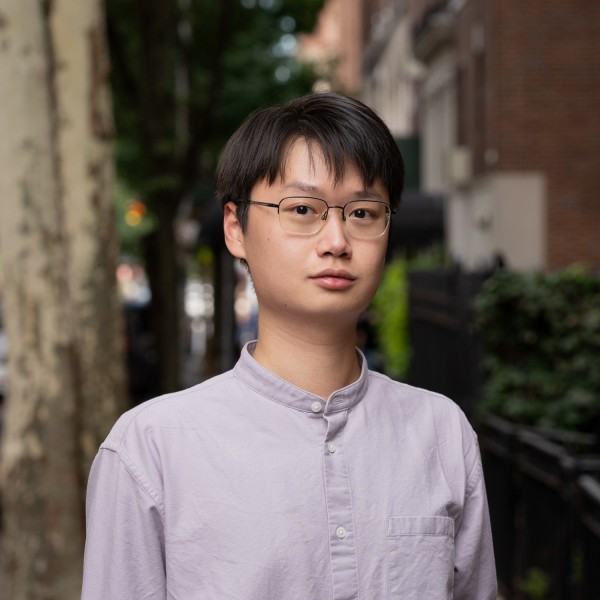Outdoor dining plan sparks space conflicts among Village residents, businesses
As New York City’s Open Restaurants program moves toward becoming permanent, Greenwich Village businesses owners and area residents take different stances on the benefits and drawbacks of outdoor dining.
December 12, 2021
New York City’s Open Restaurants program is on track to become permanent. Since its emergency authorization due to COVID-19 in June 2020, more than 10,000 restaurants have enrolled in the program, which allows them to expand dining areas onto city sidewalks and streets. Despite being in the process of recovery from the pandemic, the city’s Department of Transportation launched 2022 applications for the program on Dec. 9.
“During the pain of the pandemic, New Yorkers helped us reimagine miles of our streets as lively spaces where we can dine out, meet with friends and neighbors, or just enjoy our neighborhoods,” DOT commissioner Hank Gutman said while announcing the program’s expansion. “This fantastic program is getting better and better as we work hard to ensure people around the city can access these vibrant public spaces right in front of their doorsteps.”

But while many business owners support the outdoor dining initiative, some Greenwich Village residents see the outdoor dining structures as a nuisance. A lawsuit from 22 New York City residents against the state of New York argues that outdoor dining has had an “ongoing negative impact” on neighborhoods and their residents, causing noise pollution and piles of trash, as well as making it difficult to navigate sidewalks filled with crowds of diners.
One of the plaintiffs, who has a hearing disability, claims that outdoor venues block her view from the sidewalk when trying to cross the road, preventing her from seeing approaching cars or bikes. Another plaintiff who uses a cane to help her walk says she struggles to walk through the narrowed sidewalk and often has to walk over unstable metal grates.
Stern first-year Maya Istafanous expressed similar frustrations, saying she is made to feel like she is interrupting dinners and disrupting waiters from serving meals.
“I understand when there are a bunch of them on residential streets, they can be really cluttering,” Istafanous said. “I get how they can be frustrating for people who live there. You start to feel like you’re in the way when you’re on the public street.”
Emily Stone, a Steinhardt sophomore, said that outdoor dining structures have made transportation through the city more dangerous.
“I’ve been in multiple Ubers that have clipped other cars or outdoor dining setups,” Stone said. “If the road isn’t big enough it can be very congested, it doesn’t help with transportation at all.”
Restaurant owners have used the Open Restaurants program to grow their venues and increase revenue. One of the businesses that has benefitted from the program is John’s of Bleecker Street, a well-known pizzeria founded in 1929. Kevin Jones, one of the managers, said that outdoor dining allowed them to stay afloat during the pandemic.
“Now, it continues to help us pay for what we lost,” he said. “Some of the neighbors don’t like it, though we haven’t got any personal complaints. But we read the papers just like everyone else.”

Caffè Reggio, a coffeehouse that has stood on MacDougal Street since 1927, has also found success from the program. The current owner, Fabrizio Cavallacci, said the restaurant had only five outdoor tables before COVID-19. Now, it has 20.
“It did help a lot,” Cavallacci said. “We did not have indoor seating, so we had only outdoor seating.”
Silver junior Christine Liu lives above one of the most popular brunch spots in Manhattan. Liu said that when she leaves her building, particularly on Saturday and Sunday mornings, it is difficult to even step onto the street.
“These streets are already chaotic — there are ambulances going back and forth, people honking, pedestrians, people on bikes — and if you cut off a section of the street because of outdoor dining, it makes it more narrow and dangerous,” Liu said. “I feel like there should be a solution.”
In an effort to resolve the tensions over the program, the DOT and the Department of City Planning are hosting roundtable discussions for residents to voice their opinions. The first community meeting was held in Queens on Dec. 6, and more will take place over the next six months.
The City Planning Commission approved a zoning amendment in October to advance a proposal to make the program permanent. If it is adopted by the city council and mayor, applications will open late next year for the permanent program’s 2023 launch.
Contact Emma Grimes at [email protected].



























































































































































